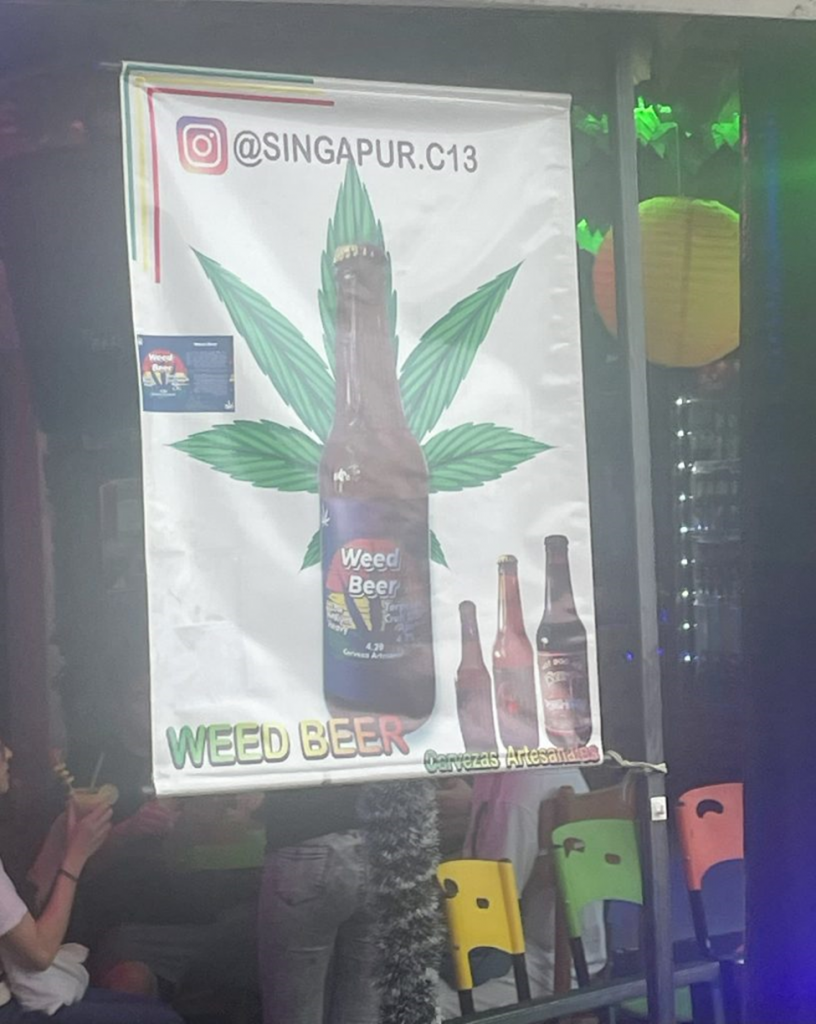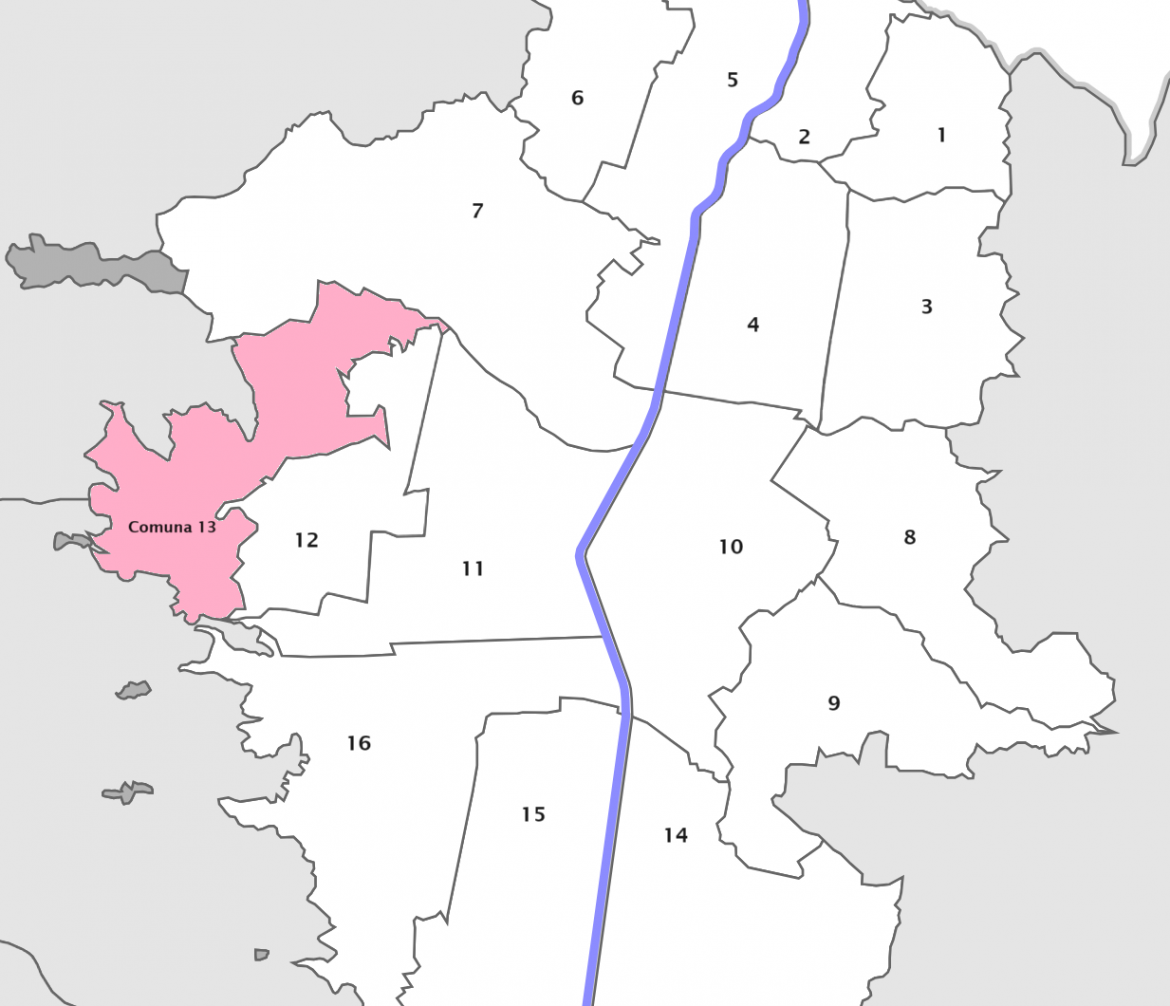Comuna 13 is not just a tourist spot for watching graffiti, buying souvenirs, and drinking beer; it is much more than that. Keep this in mind before considering a visit. It is colorful yet melancholic, marked by a history of bloodshed. Here, you encounter friendly people who have grappled with six decades of violence, insecurity, and the impact of drug trafficking, paramilitaries, and military operations.
Why is it Called Comuna 13, and Where is it?
Colombian administration has divided the urban area of Medellín into six zones, each comprising 16 communes. These communes are then segmented into neighborhoods (barrios) and institutional areas. Comuna 13 falls in Zone 4 – Center-West.
Geography and Housing of the Area
Nestled in the western hills of Medellín, Colombia, Comuna 13 is a neighborhood that paints a vivid picture of resilience and transformation. The area is characterized by its tiny alleys, steep slopes, and water channels, often exacerbated by natural disasters.
The houses here, made of bricks and cement, are huddled close together, clinging to the Andes mountains. A unique feature of these homes is their bare brick construction. Exposed bricks aren’t a design choice but rather a strategic decision. According to local guides, Comuna residents must paint their houses and leave them incomplete to exploit tax loopholes. Fully finished houses attract higher taxes and utility fees, so in Comuna 13, a predominantly low-income area, this approach helps residents save money.
The close clustering of houses makes traditional addressing impractical and GPS navigation challenging. Using postal codes instead of addresses to identify locations is a unique aspect that certainly adds to the charm and character of the neighborhood. When visiting Comuna 13, I recommend having a local guide to ensure a safe and enriching experience.
Remember, Comuna 13 is more than just a tourist spot. It’s a testament to the strength and spirit of the people who have faced decades of violence and insecurity. So, if you plan to visit, come with respect and an open heart. You’ll leave with a deeper understanding of the power of community resilience and transformation.

Comuna 13: El Barrio De Medellín Reborn with Graffiti Art
Graffiti adorns the walls of houses and businesses in the area, an anticipated sight that goes beyond mere expression of emotions and creativity. It also serves to circumvent taxes, as graffiti isn’t classified as painting a house—a point highlighted by our tour guide.
Street art is a key attraction, luring tourists to Comuna 13. The area now attracts a growing number of national and international artists eager to contribute to the beautification of a place once marked by terror.
The graffiti not only provides a tasteful visual narrative of the area’s history, reflecting the challenges faced and aspirations for the future, but it also serves as a powerful creative expression. These artworks exhibit remarkable skill and cover a broad spectrum of topics. The themes of the graffiti encompass various subjects, ranging from the historical drug era to scientific fields such as chemistry, biology, and astronomy. Additionally, they address social issues, including injustice and discrimination, and advocate for women’s empowerment. The diversity of these artistic expressions exhibits Comuna 13’s transformation of the resilience and intellectualism of the residents in the area.

However, graffiti art is all over the area, some on the slopes, and exploring them involves walking uphill extensively. Physical fitness is necessary for this tour, and navigating the labyrinthine streets can be confusing, making it advisable to take a guided tour. Wear comfortable clothes, walking shoes, a hat or cap, and sunscreen for the walking tour.
Can You Go to Comuna 13 on Your Own?
You can visit Comuna 13 alone, but as mentioned earlier, getting lost in the narrow streets is easy. A guided tour is advisable, considering this area retains remnants of its tumultuous past. Some areas may not be entirely safe, especially if you are alone, don’t know Spanish, and navigating the perplexing streets can be challenging, especially during the dark.
You can search online to find tours, but we opted for Zippy Tour Comuna 13, which operates on a tips-only basis. You can tip them between $10-15 USD, which is much more affordable compared to other groups charging up to $50. Additionally, our guide was a local resident, deeply passionate about sharing the history of the area. Having firsthand knowledge of what the community has experienced in the past, the guide provided a unique and insightful perspective.
Most tours follow a similar structure with slight customization. Typically, tour guides share the area’s history and may take you directly to the most graffiti-rich regions, offering a more immersive experience. They might also lead you to local shops or restaurants or the old houses of their relatives, providing a well-rounded exploration of the community.
Note: If you want to go on a graffiti tour on your own, use either the metro train or a taxi to reach Comuna 13. The closest Medellín Metro station to La Comuna 13 is San Javier. To reach San Javier, first, go to the San Antonio station on Line A, then descend to find the stairs leading to Line B. The most convenient way is to take an Uber or taxi to San Javier station. Once at San Javier station, take bus routes 221I or 225I from the traffic light stop on the right as you leave the station. Both buses can drop you off two blocks away from the escalators, where the Graffitour begins. Remember to inform the driver of your destination so they can guide you on where to alight.
Note: In Colombia, we preferred Uber as it was affordable and safe. We had two incidents with taxi scams where the taxi driver charged us three times what Uber asked. However, we used a taxi from the Uber app, and the charges were the same as those of a private Uber driver.
Some get to Comuna 13 by Metrocable (Gondola lift system) implemented by the City Council of Medellín, Colombia). Still, if you want to have a graffiti tour and genuinely appreciate and experience the environment in person, it won’t be the same if you use the cable car and see it from the air.
Reaching the Comuna 13 Neighborhood
We took an Uber to the meeting point with the Zippy Tour guides. We walked with our tour guide to the Comuna 13 neighborhood. Our guide stopped at multiple points to explain the area’s historical importance. He also provided insights into the history of the war on drugs before reaching the congested areas of Comuna 13 out of respect for the sensitivity of the information.
What You Will Find During Comuna 13 Tour

You’ll encounter street art performances, dances, and graffiti decorating the walls along narrow streets during your visit. The area boasts numerous kiosks selling T-shirts and other souvenirs, and friendly locals may approach you to make a purchase. There are also bars and restaurants to explore. Interestingly, you’ll come across escalators, providing a quicker means of movement, especially in emergencies, as motorized vehicles cannot access the area.

You may also find cannabis-infused beer in Comuna 13, but make sure you are with someone sober, as this infused beer can make you intoxicated, and you won’t be able to navigate through the streets of Comuna safely.
History of Comuna 13
In the heart of Medellín, Colombia, lies Comuna 13, a neighborhood with a history as vibrant as its graffiti-laden streets. Over the past five decades, this area has witnessed a dramatic transformation shaped by the socio-political landscape of Colombia.
People’s Army (FARC–EP), The Revolutionary Armed Forces of Colombia –, a Marxist–Leninist guerrilla group, was a significant player in the Colombian conflict from 1964. Initially formed as a peasant force promoting agrarianism and anti-imperialism, the FARC–EP engaged in various military tactics, including unconventional methods like terrorism. Their operations, funded through kidnap and ransom, illegal mining, extortion, taxation, and drug production, were supported by the vulnerable population of society.
Comuna 13, initially known as “Las Granjas” or “The Farms,” emerged amid this turmoil. Established by farmers fleeing violence in the countryside, it evolved into a residential area, attracting individuals seeking refuge from conflicts like La Violencia and rural disputes. However, the influx of residents brought its own set of challenges. In the 60s and 70s, the neighborhood grappled with violence from drug gangs, the military, and guerrillas. Influential figures like Pablo Escobar, a billionaire and king of Madeline drug cartels, further exacerbated the issues, while the presence of paramilitary and guerrilla groups instilled fear and harm.
During the Cold War, Colombia was caught between two superpowers, the United States and Russia. Pro-Russian individuals profited from growing, processing, and shipping cocaine to the USA, while American importers reaped benefits as well. This period was marked by Colombians being globally portrayed as isolated and unable to manage their land.
In 2002, a significant operation named “Operation Mariscal” worsened the situation, resulting in numerous injuries and deaths, including among children. However, the resilience of Comuna 13 shone through. In 2017, FARC officially ceased to be an armed group, disarming itself and transforming into a legal political party. Some dissident factions continued with drug trafficking, albeit on a smaller scale.
Today, Comuna 13 stands as a testament to the resilience and transformation of its people. For a deeper dive into its history, ‘Cocaine, Cartel, and Crackdown’ by Films Media Group, 2017, is highly recommended. Accessed on Video on Demand at link.
What Not to Do During the Visit Comuna 13?
- Comuna 13 has a tumultuous history, and many residents may have experienced hardship. It’s important to respect their privacy and not take photos without permission, as people still live there.
- Many murals and graffiti in Comuna 13 hold deep significance. Avoid defacing or disrespecting these artworks and any memorials in the area.
- Avoid wearing expensive jewelry, carrying large amounts of cash, or displaying valuable electronic devices to reduce the risk of attracting unwanted attention.
- Keep a close eye on your belongings to prevent theft. Use a secure bag and be cautious of pickpockets, especially in crowded areas.
- If you choose to take a guided tour, follow the guidelines provided by your guide. Stay with the group and adhere to safety instructions.
- Avoid visiting Comuna 13 during late hours, as safety conditions may vary, and the area might be less secure after dark.

3 comments
It’s remarkable to pay a visit this site and reading the
views of all colleagues on the topic of this post, while I am also eager of getting know-how.
I am really grateful to the holder of this web page who
has shared this impressive piece of writing at at
this time.
Wonderful goods from you, man. I’ve understand your stuff previous to and you’re just too
great. I really like what you have acquired here, I really like what you’re
stating and the way in which you say it. You make it entertaining, and you still
care about keeping it smart. I can not wait to read far more from you.
This is actually a great website.